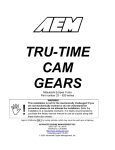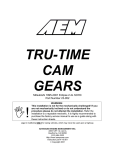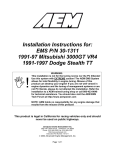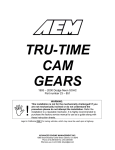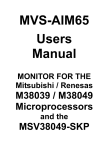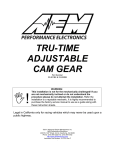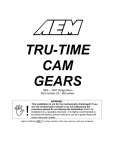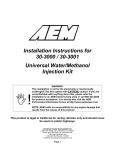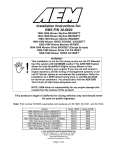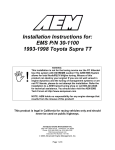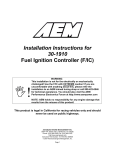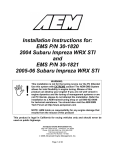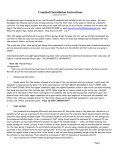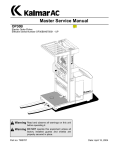Download Mitsubishi Lancer Evolution Part number 23 – 831 series
Transcript
TRU-TIME CAM GEARS Mitsubishi Lancer Evolution Part number 23 – 831 series ,! WARNING: This installation is not for the mechanically challenged! If you are not mechanically inclined or do not understand the procedure please do not attempt the installation. Refer the installation to a reputable mechanic. It is highly recommended to purchase the factory service manual to use as a guide along with these instruction sheets. Legal in California ONLY for racing vehicles, which may never be used upon a highway. ADVANCED ENGINE MANAGEMENT INC. 2205 126th. St. Unit A Hawthorne, CA 90250 Http://www.aempower.com Instruction part # 10-7013 © 2003 Advanced Engine Management, Inc. You have just purchased the BEST adjustable cam sprockets available. These AEM billet aluminum adjustable cam sprockets are CNC machined from billet aluminum and then laser etched with cam timing marks for adjustment up to ±10° at the cam or ±20° at the crankshaft. Using the vernier scale on the sprocket hub helps to do the cam timing changes quickly and accurately. The inner hub is anodized for lasting beauty and resistance to corrosion. The out gear sector is hard anodized for resistance to wear. We have found that there are significant power gains to be made by adjusting the cam timing even with stock cams and compression. Adjustable cam sprockets are usually required in applications where an aftermarket or reground performance cams are installed or the cylinder head has been milled 0.005” or more. The use of these cam sprockets allows the extraction of maximum power from your engine. We have recorded gains of up to 10~15 horsepower due to cam timing tuning using adjustable cam sprockets. When an aftermarket or reground cam is installed, the original manufacturer’s cam timing specifications are no longer accurate. The adjustable cam sprocket allows you to make necessary adjustments to cam timing to maximize the performance of your engine. This is accomplished by “degreeing in” the optimum cam timing for a particular engine set up. The adjustable cam sprocket is especially effective when used with heads that have been milled. The adjustability of the sprocket allows the accommodation of the changes in cam timing due to the variation of timing belt length from the bottom sprocket to the top sprocket when the head is milled. If the head has been milled 0.005” or greater the relationship between the head and the block is altered by moving the head closer to the crankshaft resulting in retarded cam timing. It must be emphasized that the preceding descriptions are generalizations and any adjustments made must be done with a conservative approach and on a dynamometer or on a racetrack. We do not condone any illegal activity on the street. Read and understand these instructions BEFORE attempting to install this product. See reference to diagrams on back page. 1. The procedure to change the gears is identical to the timing belt replacement procedure outlined in the factory service manual. 2. Obtain a suitable box or container to hold the hardware that will be removed from the engine during this installation. This will aid in the prevention of lost nuts and bolts. 3. Disconnect the negative battery terminal before starting these procedures. 4. Removal of cam cover (a) Remove the top center cover. i) Clean the area underneath the center cover. This is to ensure that you do not allow any debris to contaminate the engine internals. (b) Remove the spark plug wires from the spark plugs but do not remove the spark plugs at this time. Set the spark plug wires away from the area of work. (c) Remove the top cam gear cover. (d) Remove the cam cover. (e) Remove the spark plugs. i) The removal of the spark plugs will make it easier to rotate the engine by hand. Care should be taken not to allow any small items to fall into the open spark plug holes while you continue to install the cam gears. Lay a rag over the open spark plug holes. 5. Removal of timing belt front covers (a) Raise the front of the vehicle and support it using properly rated jack stands. It is important for safety reasons to use adequate supporting equipment to prevent injury or damage to the vehicle. (b) Remove the front left wheel. (c) From underneath vehicle, remove inner debris shield from inside fender well. (d) From the engine compartment, remove all drive belts (a/c, alternator/power steering belts), and Figure 1A and 1B the water pump pulley set. (e) Put a jack underneath the engine for support and remove the front engine mount, the a/c idler pulley, and remove the front center cover. (f) From underneath, remove the crankshaft pulley and then remove the front lower cover. 6. Removing the timing belt (a) Rotate the crankshaft so that the number 1 piston is at TDC on compression. Verify that the camshafts are in proper timing for this position. Fig 2A. i) The dowel pins near the center of each gear will close to the 12 o’clock position. ii) The oil pump shaft and crankshaft timing marks are lined up with reference marks on the front engine cover. (1) It is important to examine the oil pump pulley as the mark is not very easily seen (it may be obscured by dirt). The mark is a reverse embossed dot with white paint on it. (b) Loosen the center bolts on both cam gears. i) These bolts are installed at 68 ft-lbs of torque from the factory so do not rely solely on the tension of the timing belt to hold the cam gears in position. ii) The camshafts have hex flats between cylinders 1 and 2. Using an appropriately sized wrench, hold the camshaft at the hex flats as you loosen the cam gear’s center bolt. (c) Remove the timing belt from the two cam gears. This is an appropriate time to replace the timing belt if replacement is due or is close to the replacement interval. (d) Remove the two OE cam gears from both camshafts. (e) After removing the belt align the oil pump sprocket with the previously identified marks on the front of the engine. Fig 2B. i) Remove the plug on the rear side of the engine block and insert an 8mm rod into the hole to lock the pump shaft in position. (1) The oil pump shaft also includes the counter-balance shaft. This shaft needs to be locked in place during the installation of the timing belt. Figure 2A 7. Installing the Tru-Time Cam Gears. (a) Remove the cam gears from the packaging and lay them down on a flat surface. (b) Make sure that the timing marks on both gears are set up at 0° and tighten the bolts. i) If the OE intake cam gear is equipped for a cam angle sensor, remove the trigger wheel from the OE cam gear and transfer Figure 2B it to the Tru-Time gear that will be used for the Intake side using the screws from the OE gear. (c) Install the gears on to the camshafts. Tighten the bolts to the proper factory specification (68 ft-lbs). As discussed in the removal section, hold the camshaft at the hex flats as you tighten the gears. (d) From the exhaust cam remove the bolt that is at the 10 o’clock position and from the intake cam remove the bolt from the 2 o’clock position. 8. Installing timing belt (a) Install the timing belt on the intake cam. Make sure that the gear is at the proper position with the pin straight up and the alignment marks are horizontal. (b) Insert a tie wrap (supplied with kit) into the open bolt hole and tie wrap the belt to the gear. (c) The exhaust cam may be off from proper time due to the valve spring acting on the cam lobes. Use a wrench to rotate the gear into proper time as you install the timing belt. Insert a tie wrap into the open bolt hole and tie wrap the belt to the gear to prevent the belt from slipping off the gear during installation. (d) Timing belt tensioner i) Try to complete the installation of the timing belt without loosening the timing belt tensioner pulley. However, if difficulty is encountered and loosening the tensioner pulley eases the installation of the timing belt on to the pulley system then the tension on the timing belt will have to be reset. ii) From beneath, remove the automatic belt tensioner. iii) On a vise, compress the tensioner until the hole in the shaft aligns with the hole in the tensioner body. (1) This procedure should be done over a 15-minute period to allow the tensioner to bleed down. If you compress the tensioner down too fast you may damage it internally (please see the factory service manual). iv) Once the tensioner has been compressed and the holes are aligned, insert a 1/16thFigure 3A, 3B, and 3C inch pin or nail into the holes to lock the tensioner in place. (e) Complete installing the belt on to the lower pulleys. i) Ensure that all the timing marks are in their proper position after the belt is installed. Any deviation from these procedures can lead to serious engine damage. (f) Install the timing belt tensioner. If you loosened the eccentric idler pulley for the tensioner you will have to reset that pulley before you complete the assembly. 9. Resetting the tension pulley (a) The following procedures are to be completed if the tensioner pulley was loosened during the removal of the timing belt. (b) With the automatic tensioner in place, loosen the tension pulley-fixing bolt. (c) With a suitable tool rotate the tension-pulley counter clockwise and apply 3 ft-lbs to the center eccentric while tightening the fixing bolt. Do not allow the eccentric to rotate with the center bolt as you tighten it (refer to factory service manual). (d) Measure the protrusion of the auto tensioner. It should be 4 ± 2mm, if not repeat the pulley adjustment procedures. (e) Once adjustments are complete remove the tie wraps securing the timing belt to the cam gears and re-install the bolts. Tighten the adjustment bolts of each cam gear to 15 ftlbs. Remove the lock pin for the oil pump shaft described step 5e. i) Rotate the crankshaft by hand in the normal direction of engine rotation at the crankshaft. (1) Do this several times and make sure you do not feel any resistance to rotation. (a) With the spark plugs out of the engine the crankshaft should rotate freely. If resistance is encountered check to see that the timing marks on all the pulleys line up when the crankshaft is at TDC and/or that the oil pump Figure 4 shaft is not locked. (2) Check the timing marks for both the camshaft and crankshaft with each revolution and that the oil pump shaft marks line up every third revolution. Failure to ensure that engine is in proper time will result in engine damage. 10. Assembly of engine components (a) Once the timing belt is installed and cam timing verified the assembly of the motor is the reverse of the procedures just outlined. 11. Cam timing adjustment procedures (a) The performance of an aftermarket cam can be optimized by using the AEM cams gears by “degreeing in” the proper cam timing for your particular engine set up. This procedure is best carried out on a dynamometer so that quantifiable results can be measured. The advancing or retardation of cam timing will affect the peak power of the engine by moving the power band up or down. Usually, advancing the cam gives more low-end power and, conversely, retarding the cam timing gives a higher peak rpm and power. We must emphasize that this is only a generalization and that you must perform dyno/track testing to fully realize the benefit of these sprockets. In the absence of a dyno, timed acceleration tests can be performed. (We do NOT condone illegal activity on the street and STRONGLY recommend the timed acceleration tests be carried out at a racetrack.) The method we use to perform the timed tests is to start at a constant engine RPM in second gear (both for manual and automatic transmission) and then accelerate to the vehicle redline while recording the time it takes to reach redline. We perform this test at least 3 times to establish an average reference point. Notice that there is no shifting or tire burning (if you do have a traction problem, use a higher gear) in this procedure. Using this procedure will give reliable and repeatable data. (b) As outlined at the preface of these instructions adjustments to the cam timing must be done with a very conservative approach. Excessive movement of the cams during adjustment increases the likelihood that the pistons and valves will touch. (c) All testing should be done on a chassis dynamometer or at the test track. Under no circumstance should you resort to testing on public roads. (d) For early Mitsubishis equipped with a cam driven distributor. i) Verify that the ignition timing is correct (use a timing light to do this, do not guess). The ignition timing must be verified EACH time the cam timing is changed because the cam drives the distributor. Any change to the cam timing will affect the ignition timing. ii) To change the cam timing, loosen the three retaining bolts (figure 1) in the slotted holes in the inner hub. Rotate the cam to the desired position and retighten the three retaining bolts to 15-ft. lbs. If the head is milled, then retarding the exhaust cam lobe timing must be carried out with extreme care. You must have at least .060” between the piston and the valve. (e) After the cam timing change is made, re set your ignition timing and go out and try your acceleration test or perform dyno testing. You must check your fuel calibration after each cam timing change in order to perform an accurate test. The cam timing has a profound effect of the air/fuel mixture and if it is not optimized for each cam timing setting you will not know if the effect of the change in cam timing is positive or negative. (f) When you have concluded testing, re check the cam bolts for tightness, apply Loctite® “red” to the three retaining bolts, re install the cam belt cover and know that you have installed the best cam timing sprocket(s) available. Caution: Cam adjusting bolts loose. Tighten before starting engine. For Technical Inquiries Please E-Mail us at [email protected]







